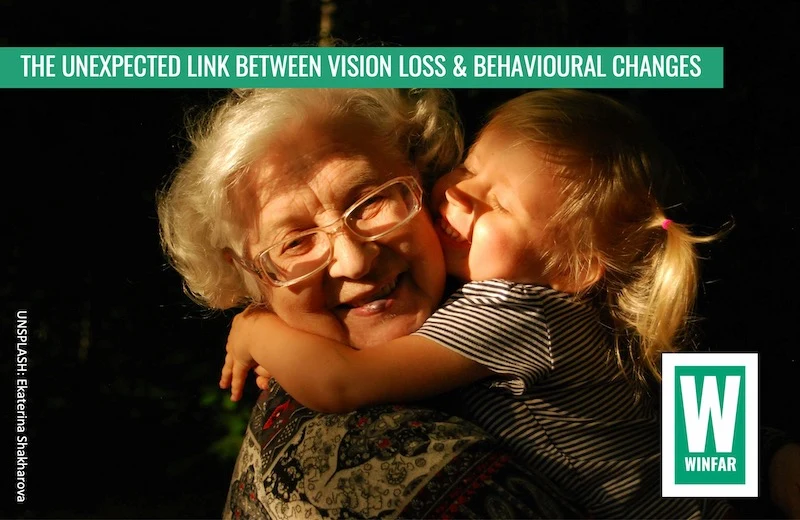People often think that failing vision comes hand in hand with getting older, but nothing could be further from the truth! Some people in their 90’s still have excellent vision. Good vision is all about care and maintenance.
Yes, a certain amount of deterioration is normal, and to be expected. But regular eye exams and timely intervention can go a long way to maintaining good vision. That said It’s important to distinguish between natural changes that occur with ageing and actual vision issues – problems that are not naturally occurring age-related changes, but rather warning signs of serious eye conditions.
Naturally occurring issues often seen in aging eyes include:
- Reduced contrast sensitivity with increased difficulty distinguishing between colours and patterns
- Greater difficulty adapting to glare when moving between light and dark environments
- The onset of floaters, namely tiny specks or threads floating in our visual field
- Decreased depth perception
- Reduced ability to see colours
- Decreased tear production leading to dry eyes
These problems are generally quite easily corrected. Glasses, contact lenses, and improved lighting should help and enable you to maintain your lifestyle and independence.
Common age-related eye problems in Seniors
The risk of certain eye diseases however also increases as you age, so awareness is key. Keep your eyes as healthy as possible by getting regular eye exams so any problems can be spotted early. Because we assume diminished vision to be part of the natural aging process, we often overlook some of the more serious vision issues. These include:
- Diabetic retinopathy
Diabetic retinopathy is caused by damage to the blood vessels in the tissue at the back of the eye (retina). Poorly controlled blood sugar is a risk factor.
Early symptoms include floaters, blurriness, dark areas of vision and difficulty perceiving colours. Mild cases can be treated with careful diabetes management. Advanced cases may require laser treatment or surgery. - Cataracts
A cataract is a cloudy area in the lens of your eye (the clear part of the eye that helps to focus light). Cataracts are very common as you get older, with 95 percent of all persons undergoing cataract surgery experiencing significant vision improvement and the remaining 5% achieving stabilisation of their vision - Glaucoma
With all types of glaucoma, the nerve connecting the eye to the brain is damaged, usually due to high eye pressure. The most common type of glaucoma (open-angle glaucoma) often has no symptoms other than slow vision loss. Great advances have been made in both diagnosing and combatting glaucoma-related blindness - Age-related macular degeneration (ARMD)
Age-related macular degeneration (AMD) is an eye disease that can blur your central vision. It happens when aging causes damage to the macula — the part of the eye that controls sharp, straight-ahead vision. The macula is part of the retina (the light-sensitive tissue at the back of the eye). ARMD affects more that 20 percent of seniors in their eighties with central and fine vision loss. Progression can be slowed with specific vitamin supplements and by eating a balanced diet rich in fish, fruits, vegetables, and nuts.
Behavioural red flags that suggest vision loss
With so many physical adjustments and accommodations being made throughout the aging process, it’s fairly common for vision changes to be written off as part of the natural ageing process. But if you are concerned about behavioural changes in your older adult, vision loss is a serious consideration.
According to the Foundation for the Blind, the following behaviours are indicators of vision loss that warrant a trip to the eye doctor to see if there’s an underlying eye problem:
Mobility
– Frequently bumping into objects or brushing into walls while walking
– Having difficulty walking on irregular surfaces
– Stepping hesitantly
– Going up/down stairs with increased caution, and slower pace
– Foot shuffling
– Missing objects by under-reaching or overreaching for them
Indicators involving daily activities
– Discontinuing once favoured activities or doing them differently, such as reading, TV watching, driving, walking etc
– Squinting or head tilting to focus on an object
– Having difficulty identifying faces or objects
– Frequently having trouble finding things even in a familiar environment
– Having trouble identifying colours or selecting odd colour or pattern combinations when dressing
Indicators during eating or drinking
– Having problems getting food onto a fork
– Difficulty with cutting food or serving it from a dish
– Spilling food off the plate while eating
– Pouring liquids over the rim of a glass
– Knocking over a glass when reaching across the table for another item
Indicators involving reading or writing
– New unwillingness to read mail, newspapers or books
– Holding reading material very close to the face or at an angle
– Writing less clearly and having trouble writing on a line
– Finding lighting that had formerly been sufficient to be inadequate for reading or other tasks
How often should seniors get their eyes checked?
The fact is that everyone age 65 or older should have a comprehensive eye examination performed by an ophthalmologist every one to two years at a minimum, unless they have an existing risk factors that would warrant more frequent screening.
Risk factors can be based on a person’s medical history, such as being diabetic, or their race (certain ethnic groups have a higher risk of certain conditions) or their family history. Newly diagnosed diabetics should have a baseline eye examination to establish a benchmark for monitoring intra-ocular blood vessel damage caused by diabetes.
After performing a comprehensive exam and taking a detailed medical and ophthalmic history, including the use of medications, your eye doctor will tell you whether any significant eye conditions were detected, their severity, and the plan for treating and monitoring your condition.
Tips for healthy eyes at any age
Your visual health is a key component of your overall health and regular eye exams should receive the same priority as your medical check-ups. Timely intervention is essential for maintaining good vision. It’s time you made your vision care a priority?
There are things you can do to take good care of your eyes and help keep them healthy as you age:
– Protect your eyes from harsh sunlight, by wearing sunglasses that block ultraviolet (UV) radiation and a hat with a wide brim when you are outside.
– Stop smoking.
– Make smart food choices.
– Excercise, stay active and maintain a healthy weight.
– Maintain normal blood pressure.
– Manage diabetes (if you have it).
– If you spend a lot of time at the computer or focused on one thing, take a break every 20 minutes to look about 20 feet away for 20 seconds to prevent eye strain.
Source articles:
https://www.allaboutvision.com/en-ca/over60/vision-changes/
https://www.nei.nih.gov › eye-conditions-and-disease
https://www.nei.nih.gov/learn-about-eye-health/eye-conditions-and-diseases/age-related-macular-degeneration
https://dailycaring.com/catch-aging-eyes-problems-before-major-vision-loss
mayo clinic > Diabetic retinopathy – Symptoms & causes

